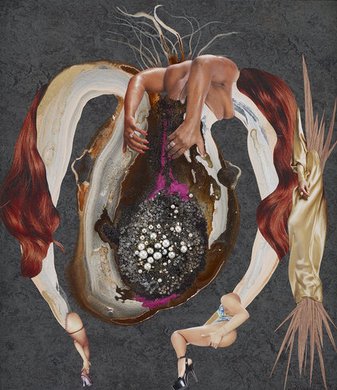While roaming around the International Center for Photography, you must have caught a glimpse of the Installation by Rabih Mroué. The first thing you will think of is that the room is dark. Indeed, it is quite dark! The room is only dimly lit by a video of Mroue speaking, projected onto the wall at the front. At first glance, you would think it was just like any other dark room in the museum. However, upon entering, you are greeted warmly with a pixelated photograph of a man… pointing a gun straight at you. As you look around, you will see similar pixelated photographs, some of men carrying guns and some of children. All of these photos are titled “Blow Up,” with a different number attached.
This was by far my scariest encounter with a two-dimensional gun. When I watch movies that involve gun violence, I always know that no one is actually shot, or if someone did, I do not have any knowledge about it. Despite the fact I am not a fan of violence, I am typically just entertained by the scenes, as the produces intended to do. In this room though, I know the guns aren’t just used as props. They are meant to cause harm. These photos were taken by Syrian activists during the country’s civil war. Many of them were taken by mobile phone cameras. They took these photos and shared them on the internet with social networking sites to show the world what the Syrian media can not. It is said that one of the men in the installation shot his photographer.
Mroué did an amazing job at bringing this installation to life. Every aspect made me think or feel some sort of emotion. First, the dark room made it eerie and mysterious. Then, the first photo I see upon entering is just a shock. How many times in your life do you see a photo of someone pointing a gun directly at you as the first thing you see when you enter a room? After I enter and look around, I see blurry pictures. They may be low quality, but the messages were clear. The children, the murderers, the soldiers; I could see the fear, anger, and envisioned the violence. I could see the chaos. I felt fear just looking at the guns surrounding me. If I feel this way by simply looking at photographs, I can not begin to even imagine the fear that the activists felt. They were there right in front of the gun barrel, about to be and many times shot. It really makes me wonder, what it is like to be in Syria right now in the midst of their civil war? What gives these photographers the courage to go into such dangerous territory to record and photograph the events?
These pixelated photos answers many questions about Syria but leaves so many more to be answered. How did you feel after you saw Mroue’s installation?

Photo taken from: http://www.artexchange.org.uk/exhibition/rabih-mroue-the-pixelated-revolution


















